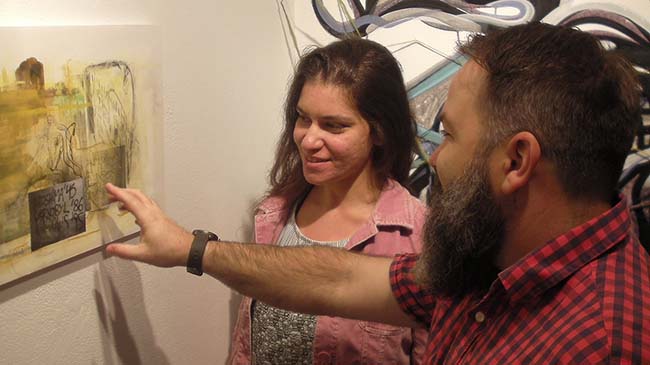By Steven Krolak
Just getting there is a big part of the adventure.
You pass first through a pair of ominous fire doors in Knobview Hall, marked “Keep Closed,” proceed down a long and gritty passageway lined with cubbies, garbage cans, shelving racks, canisters of unknown substances and rolls of plastic sheeting, turn left into a small room containing two large vats filled with undetermined grey gloppiness, before moving — slowly now, because you’re really not sure you belong here – toward a sliver of light shining out from a gap in the far wall. You slip through the gap and . . . enter the SpaceLab.
The SpaceLab is many things.
“It’s a space for research and development, a space for students to experiment with their work and with aspects of exhibition and presentation,” said Brian Harper, associate professor of fine art who teaches ceramics.
Harper, together with a small group of art students, built the SpaceLab over Thanksgiving break in 2009. They created it out of surplus storage space at the back of the ceramics studio. with wood, drywall and paint purchased by the Dirt Bags Art Club, a student organization.
It’s here in the SpaceLab that students may first see their work on a wall. Or next to a wall. Or protruding from a wall. In space, anyway. And that’s important, because the impact of a work of art has a lot to do with how it is staged.
“Students who exhibit here get to see what happens with the relationships between larger, more expressive works and smaller works that are more reflective,” Harper said.
In the SpaceLab, anything is possible. The walls themselves can be moved to configure the space to suit the artist’s needs. So while it can be as big as 16 feet long by 8 feet wide, it has been compressed to a mere slit that required visitors to press through sideways. On the other hand, with the walls painted black, it’s infinitely huge. The adaptability allows the space to be used for sculpture, painting, drawing, photography, installations, and multimedia combinations of all. The movable wall also allows for works of even very great size to be properly photographed, a key part of an artist’s life.

IU Southeast student Chelsea Markuson and professor Brian Harper discuss technique in the Space Lab.
Because it is so small, and so casual, the SpaceLab is also where ideas and people and art come together to make unexpected things happen. Nothing is final here, everything is fluid.
According to Harper, there have been 83 shows in the Space Lab, counting “Connected. Disconnected,” a multimedia display by IU Southeast senior drawing student, Chelsea Markuson of Louisville, Ky. With its partly static, partly dynamic nature, three-dimensional yarn trajectories bursting out of the wall plane, and spiral compositions painted directly onto the enclosing surfaces, is the kind of show that could only happen here, Markuson said.
“My method of coming to terms with my work as a student artist is experimentation,” she said. “I need to get my hands dirty and make mistakes and get feedback as I’m working. I can’t do that in my home or in the Barr Gallery. The SpaceLab is so DIY, it has that underground vibe that is really important.”
For Markuson and other student artists, the SpaceLab is clearly not just a place to hang art, but an integral part of the creative process. Markuson appreciates the comments of students from other disciplines, who help her further refine her vision.
“Freedom is the beginning of creativity,” Markuson said.
Show 84 is already in the works: “Shifting Identities,” by Rachael Bailey of New Albany, Ind. Bailey is a double major in drawing and painting, and her work speaks to personal history as a defining force in identity.
“We place so much importance on our identity, but that identity is constantly changing due to choices we make, environments we put ourselves in, things that get thrown our way and how we handle them, and all of that shapes the way we interact with the world.”
She expresses this complex human experience in media including ink, oil paint, mylar, graphite and other materials, in layered works that allow the viewer to see through to deeper levels of material and meaning. The SpaceLab is ideal for her vision, because it will allow her to experiment with lighting from behind to enable her unique vision to come alive.
“The SpaceLab is awesome,” Bailey said. “I learn how to hang the work, but also how to make flyers, plan the opening and make an artist’s statement, so it’s good practice for knowing how to create a real show.”
The SpaceLab may be one of the smaller gathering places on campus, but it’s influence is great. And it’s definitely the only room at IU Southeast with its own website.
“This little box has done so much to change the art programs, because it has given students the freedom to experiment,” Harper said.
Rachael Bailey’s solo show, “Shifting Identities,” runs from Nov. 10-14 in the SpaceLab. The opening will take place on Nov. 10, 6-7:30 p.m. Thumbnail photo: “Connected. Disconnected” by Chelsea Markuson (www.chelseamarkuson.com).


